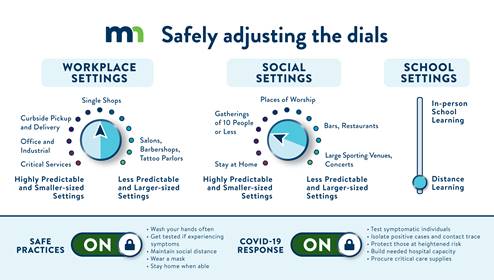5-14-2020 COVID-19 Update from the MN Department of Health
Minnesota Department of Health COVID-19 Update 5-14-2020

See the recap from MN Governor Walz Update on the Stay-at-Home Order Here
On Thursday, May 14, the Minnesota Department of Health held a conference call to brief members of the media on the latest public health information regarding COVID-19.
This is a summary of that media briefing.
Update from MDH Commissioner Jan Malcolm:
- Globally, 4.3 million COVID-19 cases and 297,000 deaths
- In the U.S., 1.4 million and 84,100 deaths
- In Minnesota, 13,435 confirmed cases and 663 deaths
- Minnesota’s doubling time of case infections is the same as it was as last week — 10 days
- 493 people hospitalized and 203 in ICU
- Anyone with COVID-19 symptoms can and should be getting tested
- When people test positive or if they feel sick without a test, please self-isolate and stay at home. We all need to do our part to protect our own health and those of people in the community.
Update from MDH Infectious Disease Division Director Kris Ehresmann:
- We have had an increase in the number of people tested. MDH reached an internal milestone by completing 650 case interviews in a single day. 500 of those were completed by MDH staff, 150 by local public health.
- Stearns County was able to conduct 49 interviews
- Minnesota ramping up testing in long-term care facilities as part of the governor’s five-point plan.
Update from MDH State Epidemiologist Ruth Lynfield
- MDH is expecting a third shipment of Remdesivir tomorrow. The federal government has begun sending out an allocation to states and territories, to the veterans administration system as well as the Indian health service.
- Minnesota expects to receive enough to treat approximately 145 people for a 10-day course, and more individuals if they are on a five-day course.
- The determination about a 10-day versus a five-day course has to do with the recommendations and the emergency-use authorization from the FDA as well as the MDH recommendation that a 10-day course be considered for those most severely ill (people receiving mechanical ventilation or extracorporeal membrane oxygenation).
- For other people who are infected and have severe illness, MDH is advising clinicians to evaluate them at the five-day point and determine if five days seem clinically indicated or if they should continue.
- MDH is planning their allotment to Minnesota facilities. They do this looking at the census in facility of COVID-positive patients who are hospitalized. Based on that they come up with a proportion that goes out to the facilities based on the amount that they get.
- MDH has heard from the assistant secretary of preparedness and response that MN is expected to get shipments of Remdesivir on a weekly basis each week for the next four weeks.
- They will determine the amount that comes to Minnesota based on the census of COVID-positive patients in MN hospitals.
- The MDH does not know how much remdesivir they’ll be getting in a particular week. And the MDH does not know which day they’ll be getting their supply.
- Indicators of whether to dial back Minnesota’s safety measures:
- The proportion of tests that are positive. A positivity rate of 15% or more on average over 7 days, or a daily percent positive that increases 5 percentage points over 14 days is of concern. Currently we are at a 14% average rate and we have decreased 7 percentage points.
- The current threshold for polymerase chain reaction (PCR) testing capacity. The current threshold, and this may change, is if PCR testing capacity drops below 5,000 daily tests on average over 7 days. Currently, we have exceeded that. We have had a 7,791 daily average supply capacity on hand. MDH assess this on a daily basis.
- The case doubling time. This is the days for number of new confirmed cases to double and whether it is, on average, a rate of 5 days or faster over a 14-day period. We are currently at an approximate 9.5-day case doubling time.
- The last measure, and this is the measure for which Minnesota has not met its goal, is community spread without known contact. This gives us a sense of whether there is more widespread transmission in our Minnesota communities. The threshold for that is the percent of unknown contacts for a case is above 30%, on average, over 7 days or if the rate climbs more than 5 points in 14 days. Currently 36% of our cases have no known contact, and our rate has increased 16 percentage points. Of the measures described, this is the one that has not met the MDH goal.
- Other measures the MDH is also interested in looking at hospitalization and ICU rate, cases among health care workers, PPE supplies on hand, trends on COVID-like illness, and the COVID-related death rate. It’s taking the MDH a little bit of time to develop the goals. But please look out, because the MDH plans to have some additional measures on its dashboard so people can follow the data they’re collecting and able to assess.
Update from MN Homeland Security Director Joe Kelly
- 20 members of the Minnesota Army and Air National Guard have been asked to conduct COVID-19 tests in long-term care facilities
- The National Guard members are trained medics
- They complete about 4 months of skills training on patient care and treatment techniques as well as emergency medical procedures, and they’re required to earn certification as EMT’s.
- On the civilian side, many of them work clinical jobs at hospitals, clinics and other health care facilities
- If you’re being tested by a National Guard member you should know that you’re in good hands.
- They’ll be deployed for this testing surge and released when their assistance is no longer needed.
- Today there are about 120 MN National Guard members on duty for the coronavirus response.
Additional Notes from today’s meeting
- The MDH officials were asked a question about whether they’re concerned about the state reopening at a time when all of the cases are going up. Commissioner Malcolm said the reopening is contingent on businesses reopening using best practices to keep workers and customers safe. And for all Minnesotans to adhere to health guidance. The answer is that we need to keep track of these metrics and see if they’re within the capacity of the health care system to treat people on a week-to-week basis.
- Commissioner Malcolm says a safe gathering of 10 people or less would involve being 6 feet apart, being outside, wearing masks, and not gathering if someone in the group is ill. Elderly people should still stay home. Don’t have a prolonged face-to-face conversation with an elderly neighbor because this virus has not gone away. It’s up to all of us to keep transmission down.
- The National Guard has now started conducting COVID-19 tests at long-term care facilities. They’re testing all staff and residents at facilities that have had known cases. But the goal is that facilities would be working with their usual care provider.
- 98.8% of the people who have died in Minnesota have had an underlying health condition. The MDH will consider making this information available on its website dashboard going forward.
- Minnesota’s general rate of community spread has been “pretty moderate” according to Malcolm.
CURRENT STATUS OF MN GOVERNOR’S SAFETY DIALS TO REOPEN THE STATE:

Brooklyn Center | Brooklyn Park | Crystal | Golden Valley | Maple Grove | New Hope | Osseo | Plymouth | Robbinsdale


